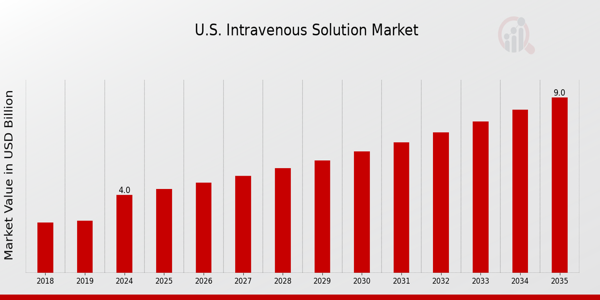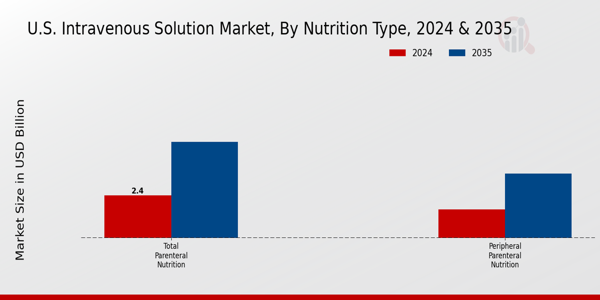US Intravenous Solution Market Overview
The US Intravenous Solution Market Industry is expected to grow from 4.0(USD Billion) in 2024 to 9.0 (USD Billion) by 2035. The US Intravenous Solution Market CAGR (growth rate) is expected to be around 7.651% during the forecast period (2025-2035).
Key US Intravenous Solution Market Trends Highlighted
Several significant market trends are currently influencing the US intravenous solution market. The rising incidence of chronic illnesses like diabetes and cancer, which necessitate frequent hospital stays and intravenous treatment, is a major factor propelling the market. Since senior individuals are frequently more vulnerable to numerous medical ailments that call for such treatments, the US's aging population is another important factor driving up demand for intravenous solutions. This industry is also being driven by improvements in medical technology and heightened patient knowledge of intravenous treatments. The creation of novel formulations and tailored solutions that address the unique requirements of patients are among the opportunities in this field that should be investigated.
Innovative intravenous solutions that can be delivered outside of traditional hospital settings are also made possible by the growth in outpatient operations and home healthcare services. Pharmaceutical firms and medical professionals want to work together to develop intravenous treatments that are more patient-friendly and efficient. The use of IoT-enabled devices and smart infusion pumps in the delivery of intravenous treatments has been increasingly popular in recent years. This technological development improves patient safety and treatment results by enabling improved intravenous therapy monitoring and management.Moreover, the regulatory landscape in the US is evolving, focusing on improving the quality and safety standards of intravenous solutions. These trends highlight the dynamic environment of the US Intravenous Solution Market, filled with opportunities for growth and innovation.

Source: Primary Research, Secondary Research, MRFR Database and Analyst Review
US Intravenous Solution Market Drivers
Increasing Hospitalizations and Chronic Illnesses
The US Intravenous Solution Market Industry is experiencing significant growth due to a rising number of hospitalizations driven by chronic illnesses such as diabetes, cardiovascular diseases, and respiratory disorders. According to data from the Centers for Disease Control and Prevention (CDC), approximately 45% of adults in the US live with one or more chronic conditions, which is anticipated to lead to a surge in demand for intravenous therapies.
This rise correlates with an increase in treatments that necessitate IV solutions, as hospitals adopt these therapies for their effectiveness in delivering medications and nutrients. Major healthcare institutions like the American Hospital Association have acknowledged this trend, advocating for enhanced support systems to manage these chronic illnesses, thereby propelling the growth of the US Intravenous Solution Market.
Advancements in IV Therapy Technology
Technological innovations in intravenous therapy are a key driver for the US Intravenous Solution Market Industry. Developments such as smart infusion pumps and new formulations of IV solutions have greatly improved patient outcomes and safety. The Food and Drug Administration (FDA) has approved numerous advanced medical technologies aimed at enhancing IV administration, indicating a market trend toward safety and efficacy. For instance, a report from the FDA confirmed that the introduction of smart pumps has reduced medication errors by 40%, leading to increased acceptance of IV therapy among healthcare practitioners.
As hospitals continue to upgrade their technologies, the demand for IV solutions will correspondingly rise.
Elderly Population Growth
The aging population in the United States is significantly influencing the US Intravenous Solution Market Industry. The US Census Bureau data indicates that by 2030, the number of older adults aged 65 and over is projected to reach 74 million, nearly doubling from 37 million in 2007. As the elderly population is more susceptible to health complications that require IV treatments, this demographic shift is expected to enhance the demand for intravenous solutions.
Healthcare providers are increasingly emphasizing geriatric care and tailoring treatments for the older population, thereby creating opportunities for market growth in intravenous solutions.
US Intravenous Solution Market Segment Insights
Intravenous Solution Market Nutrition Type Insights
The US Intravenous Solution Market, notably represented through the Nutrition Type segment, illustrates a vital aspect of patient care, particularly in hospital settings where nutritional support is paramount. Total Parenteral Nutrition (TPN) and Peripheral Parenteral Nutrition (PPN) play significant roles in addressing the nutritional requirements of patients who cannot consume food orally or absorb nutrients through their gastrointestinal tracts. TPN, often administered through central venous catheters, is crucial for patients with gastrointestinal disorders, offering them a complete and comprehensive nutrient profile. It serves a diverse population, including those with severe burns, inflammatory bowel disease, and cancer, where traditional feeding methods are not viable.
On the other hand, PPN is commonly used for patients requiring less intensive nutritional support and can be delivered through peripheral veins, making it more accessible and easier for many healthcare providers to manage. This segment is particularly important for patients who may need short-term nutritional intervention without the risks associated with central venous access. The US Intravenous Solution Market data suggests a growing demand for these nutritional solutions, driven by an increase in chronic illnesses, an aging population, and advancements in intravenous therapy technology. Moreover, rising awareness regarding the benefits of proper nutritional support is propelling market growth, with healthcare facilities investing in these solutions to improve patient outcomes.
However, challenges such as regulatory scrutiny, supply chain disruptions, and the need for skilled healthcare professionals to administer these intravenous solutions effectively could affect the market dynamics. Opportunities also arise from the rapid advancements in formulation and delivery methods to enhance the efficacy of TPN and PPN, which may drive innovation in product offerings. The US Intravenous Solution Market statistics showcase a balance between the TPN and PPN segments, each catering to different patient needs and emphasizing the importance of tailored nutritional approaches in healthcare. Ultimately, this reflects a broader trend toward personalized medicine, highlighting the necessity for healthcare systems to integrate and optimize intravenous nutritional support.

Source: Primary Research, Secondary Research, MRFR Database and Analyst Review
Intravenous Solution Market Bag Type Insights
The Bag Type segment of the US Intravenous Solution Market plays a crucial role in the healthcare sector, particularly in hospital and clinical settings where the demand for safe and efficient administration of fluids and medications is paramount. This segment is characterized mainly by Large Volume Bags, which are commonly used for administering hydration, electrolytes, and nutritional support, and Small Volume Bags, which are typically utilized for delivering precise doses of medications. The preference for Large Volume Bags arises from their efficiency in handling large fluid volumes, making them ideal for patients requiring extended treatment durations.
Meanwhile, Small Volume Bags are instrumental in minimizing waste and managing the administration of high-concentration medications, thereby streamlining the treatment process. The growing prevalence of chronic diseases in the US is driving the adoption of these products, as they are essential in sustaining patient care protocols. Moreover, advancements in bag manufacturing and materials enhance the usability and safety features of these intravenous solutions. Overall, the diversification within this segment reflects a strategic adaptation to the intricate needs of the healthcare industry, ensuring better allocation of resources and improved patient outcomes.
Intravenous Solution Market Nutritional Content Insights
The Nutritional Content segment of the US Intravenous Solution Market plays a pivotal role in supporting patient care, particularly for individuals who are unable to consume food orally. This segment comprises critical components, such as Amino Acid Solutions, which are essential for protein synthesis and are widely used in hospitals for patients requiring nutritional support. Carbohydrates provide a necessary energy source to patients, particularly in critical care settings, ensuring that metabolic needs are met during recovery. Meanwhile, Vitaminsand Minerals are crucial for overall health maintenance and play significant roles in numerous physiological processes, making their presence in intravenous solutions vital for patients recovering from surgery or illness.
Parenteral Lipid Emulsion represents another key aspect, as it supplies essential fatty acids that contribute to overall caloric intake and aids in the absorption of fat-soluble vitamins. The US market is witnessing a growing demand for these solutions due to an increase in chronic diseases, surgical procedures, and aging populations, thus driving forward the importance of the Nutritional Content segment in enhancing patient outcomes and meeting healthcare needs. As healthcare providers increasingly focus on individualized patient care, the optimization of these solutions becomes imperative to improve recovery times and overall health.
Intravenous Solution Market End User Insights
The US Intravenous Solution Market is significantly influenced by its End User segmentation, which includes Hospital Clinics, Ambulatory Surgical Centers, and Home Care settings. Hospitals and clinics represent a substantial portion of the usage, driven by the increased demand for intravenous therapies for critical care patients. These facilities often require large volumes of intravenous solutions due to the growing prevalence of chronic diseases and surgical interventions. Ambulatory surgical centers are emerging as significant users, fueled by a shift towards outpatient procedures and the need for efficient post-operative care.
The trend toward home care is also noteworthy, as patients increasingly seek alternatives to hospital stays, thus boosting the demand for intravenous solutions in home healthcare settings. This adaptation is supported by advancements in medical technology, which enable the safe administration of intravenous therapies at home. Each of these segments is pivotal to the overall US Intravenous Solution Market growth, reflecting changing patient care models and healthcare delivery systems while navigating various operational challenges and regulatory considerations.
US Intravenous Solution Market Key Players and Competitive Insights
The competitive insights of the US Intravenous Solution Market reveal a dynamic landscape characterized by several key players vying for market share in an arena largely driven by the increasing demand for intravenous treatments, healthcare innovations, and technological advancements. The sector has grown due to rising cases of chronic diseases, an aging population, and the growing prevalence of outpatient care, which necessitates efficient and effective intravenous solutions. Competition within this market is characterized by strategic partnerships, acquisitions, product innovations, and the push for enhanced safety measures in the delivery of intravenous therapies. The integration of advanced technologies, including automation and digitalization in healthcare, has further intensified competition as companies strive to enhance patient outcomes while reducing costs.
ICU Medical has established itself as a formidable competitor within the US Intravenous Solution Market, recognized for its commitment to improving patient safety and outcomes. The company has a comprehensive portfolio of products that cater to the needs of healthcare providers, emphasizing features such as smart infusion technology and integrated delivery systems that minimize medication errors. ICU Medical's strengths lie primarily in its innovation and specialization in infusion therapy, allowing it to maintain a strong market presence. Its strategic focus on developing advanced products and maintaining functional partnerships with healthcare institutions has allowed ICU Medical to build solid relationships in the industry, further solidifying its competitive edge and market footprint.
Baxter International is another key player in the US Intravenous Solution Market, boasting a broad array of products designed to meet diverse patient needs. The company’s offerings include IV solutions and administration sets, parenteral nutrition products, and various delivery systems. Baxter's strengths are grounded in its strong reputation for quality and safety, as well as its extensive distribution network that enhances its market presence across the United States. With an emphasis on innovation, Baxter has rolled out several new products and technologies that improve the efficiency and safety of infusion practices. The company has also pursued strategic mergers and acquisitions that bolster its capabilities and broaden its product offerings, reinforcing its position within the competitive landscape of intravenous solutions. Baxter's established relationships with healthcare providers and commitment to addressing evolving healthcare needs enable it to adapt to market dynamics effectively while maintaining a strong competitive stance.
Key Companies in the US Intravenous Solution Market Include
- ICU Medical
- Baxter International
- Fresenius Kabi
- Nipro Corporation
- Medline Industries
- Moog Inc.
- Braun Melsungen
- Otsuka Pharmaceutical
- Halyard Health
- Sientra
- Pall Corporation
- Hospira
- Terumo Corporation
- Smiths Medical
- Kang Hui Medical Group
US Intravenous Solution Market Industry Developments
In recent developments within the US Intravenous Solution Market, companies like ICU Medical and Baxter International have reported strong growth in demand driven by an increase in hospital stays and surgical procedures. In September 2023, Baxter International announced its acquisition of a smaller IV solutions company to expand its product portfolio and enhance supply chain resilience amid ongoing intravenous solution shortages. Fresenius Kabi has also been proactive by ramping up production capacities to meet rising healthcare needs, particularly during the ongoing challenges within the healthcare system. In addition, Nipro Corporation has introduced innovative infusion systems that cater to evolving patient care needs.
The market has seen an overall valuation increase, with reports indicating a projected compound annual growth rate of over 7% in the coming years. Challenges, including supply chain disruptions and heightened regulatory scrutiny, have further prompted companies like B. Braun Melsungen and Terumo Corporation to adapt their strategies. Recent updates in the industry highlight a growing focus on technology integration for improved patient outcomes, with digital solutions being a key aspect of competitive differentiation among major players.
Intravenous Solution Market Segmentation Insights
Intravenous Solution Market Nutrition Type Outlook
-
- Total Parenteral Nutrition
- Peripheral Parenteral Nutrition
Intravenous Solution Market Bag Type Outlook
-
- Large Volume Bags (>250 ml)
- Small Volume Bags (250 ml)
Intravenous Solution Market Nutritional Content Outlook
-
- Amino Acid Solution
- Carbohydrates
- Vitamins Minerals
- Parenteral Lipid Emulsion
Intravenous Solution Market End User Outlook
-
- Hospital Clinics
- Ambulatory Surgical Centers
- Home Care
|
Report Attribute/Metric
|
Details
|
|
Market Size 2023
|
3.65(USD Billion)
|
|
Market Size 2024
|
4.0(USD Billion)
|
|
Market Size 2035
|
9.0(USD Billion)
|
|
Compound Annual Growth Rate (CAGR)
|
7.651% (2025 - 2035)
|
|
Report Coverage
|
Revenue Forecast, Competitive Landscape, Growth Factors, and Trends
|
|
Base Year
|
2024
|
|
Market Forecast Period
|
2025 - 2035
|
|
Historical Data
|
2019 - 2024
|
|
Market Forecast Units
|
USD Billion
|
|
Key Companies Profiled
|
ICU Medical, Baxter International, Fresenius Kabi, Nipro Corporation, Medline Industries, Moog Inc., B. Braun Melsungen, Otsuka Pharmaceutical, Halyard Health, Sientra, Pall Corporation, Hospira, Terumo Corporation, Smiths Medical, Kang Hui Medical Group
|
|
Segments Covered
|
Nutrition Type, Bag Type, Nutritional Content, End User
|
|
Key Market Opportunities
|
Increased demand for hydration therapy, Growth in-home healthcare services, Rising prevalence of chronic diseases, Technological advancements in IV solutions, Expansion of hospital infrastructure
|
|
Key Market Dynamics
|
Increasing chronic disease prevalence, Growing geriatric population, Technological advancements in infusion therapy, Rising hospital admissions, Expanding healthcare infrastructure
|
|
Countries Covered
|
US
|
Frequently Asked Questions (FAQ) :
The US Intravenous Solution Market is expected to be valued at 4.0 USD Billion in 2024.
By 2035, the US Intravenous Solution Market is anticipated to reach a value of 9.0 USD Billion.
The US Intravenous Solution Market is expected to grow at a CAGR of 7.651 percent from 2025 to 2035.
For the year 2024, Total Parenteral Nutrition is valued at 2.4 USD Billion within the US Intravenous Solution Market.
Peripheral Parenteral Nutrition is projected to be valued at 3.6 USD Billion in 2035.
Major players in the US Intravenous Solution Market include ICU Medical, Baxter International, Fresenius Kabi and Nipro Corporation.
Total Parenteral Nutrition is one segment within the US Intravenous Solution Market showing significant growth potential.
Growth drivers for the US Intravenous Solution Market include rising demand for nutritional solutions and advancements in medical technologies.
Challenges in the US Intravenous Solution Market include regulatory complexities and the need for stringent quality controls.
Current global economic scenarios can influence supply chains and pricing strategies within the US Intravenous Solution Market.
By 2035, the market is anticipated to reach a value of 9.0 billion USD.
The US Intravenous Solution Market is expected to grow at a CAGR of 7.651 percent from 2025 to 2035.
The market for Total Parenteral Nutrition is estimated to be valued at 2.4 billion USD in 2024.
The market for Peripheral Parenteral Nutrition is projected to reach 3.6 billion USD by 2035.
The growth is driven by increasing healthcare needs and advances in medical technology.
Yes, there is a trend towards personalized nutrition and advancements in delivery systems.
Challenges include stringent regulations and the need for advanced manufacturing technologies.
Both segments are expected to grow significantly, but Total Parenteral Nutrition will see a larger market expansion.
















